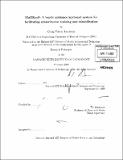MaGKeyS : a haptic guidance keyboard system for facilitating sensorimotor training and rehabilitation
Author(s)
Lewiston, Craig Edwin
DownloadFull printable version (50.14Mb)
Alternative title
Magnetic Guidance Keyboard System : a haptic guidance keyboard system for facilitating sensorimotor training and rehabilitation
Haptic guidance keyboard system for facilitating sensorimotor training and rehabilitation
Other Contributors
Harvard University--MIT Division of Health Sciences and Technology.
Advisor
Tod Machover.
Terms of use
Metadata
Show full item recordAbstract
The Magnetic Guidance Keyboard System (MaGKeyS) embodies a new haptic guidance technology designed to facilitate sensorimotor training and rehabilitation. MaGKeyS works by employing active magnetic force to guide finger pressing movements during sensorimotor learning that involves sequential key presses, such as playing the piano. By combining this haptic guidance with an audiovisual learning paradigm, we have created a core technology with possible applications to such diverse fields as musical training, physical rehabilitation, and scientific investigation of sensorimotor learning. Two embodiments of this new technology were realized in this thesis. The first embodiment, the MaGKeyS Prototype, is a 5-key acrylic USB keyboard designed for a stationary right hand. A set of three behavioral experiments were executed to investigate the manner in which haptic guidance, via the MaGKeyS Prototype, facilitates rhythmic motor learning. In particular, the experiments examined the independent effects of haptic guidance on ordinal learning, which is the order of notes in a sequence, and temporal learning, which is the order of timing variations in a rhythmic sequence. A transfer test and 24-hour retention test were also administered. Our results provide conclusive evidence that haptic guidance can facilitate learning the ordinal pattern of a key press sequence. Furthermore, our results suggest that the advantage gained with haptic guidance can both transfer to learning a new rhythmic sequence, as well as extend to a demonstrable advantage a day later. The second embodiment, the MaGKeyS Trainer Piano, is an upright piano in which the keyboard has been modified and outfitted with electromagnets in a manner similar to the MaGKeyS Prototype. The Trainer Piano helps to teach by "feel" by providing an experience in which the user feels his or her fingers being pulled down into the correct piano keystrokes as the piano plays itself.
Description
Thesis (Ph. D.)--Harvard-MIT Division of Health Sciences and Technology, 2009. Includes bibliographical references (p. 111-118).
Date issued
2009Department
Harvard University--MIT Division of Health Sciences and TechnologyPublisher
Massachusetts Institute of Technology
Keywords
Harvard University--MIT Division of Health Sciences and Technology.